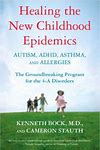Recommended Reading 1: Healing the New Childhood Epidemics: Autism, ADHD, Asthma, and Allergies: The Groundbreaking Program for the 4-A Disorders by Kenneth Bock, M.D. and Cameron Stauth
In When Learning Goes Awry we discussed many possible contributors to a student’s lack of performance. Since then we have focused mainly on physiological function. This to some extent, reflects the artificial divide between the services schools provide as “educational” vs. what insurance will cover as “medical” with the many gaps in between, as well as the move away from the country doctor who knew you personally and had a more holistic approach in comparison to today’s medical practices where there is a specialist for each function or condition. This means you need to be the lead detective as it takes a lot to find practitioners who know they need to work as part of a team and know good team members.
Here I want to focus on biochemical imbalances. The book, Healing the New Childhood Epidemics, takes a four-pronged approach to dealing with these epidemics.
1) Identify the toxin – by doing so you can start a detox regimen, eliminating the problem.
2) Eliminate the triggers – It can be hard to impossible to eliminate the toxin if something else you are doing is supporting the toxin. Dr. Bock recommends testing to take some of the guess work as well as unnecessary hardship out of the typical elimination diets.
3) Boost the immune system – According to Dr. Bock the immune system is compromised in these children and food sensitivities trigger the immune issues, keeping the child in a vicious endless cycle that is responsible for distracting the body from developing normally. Since the body and brain are too busy fighting off perceived invaders, as that is what an allergy is, it cannot expend sufficient energy to learn. Hence the connection between the medical issues and the developmental delay(s) or educational difficulties.
4) Remediation – this may be necessary to facilitate the learning in conjunction with the above three steps to close the gap or reverse the effects of the student’s condition.
![]() Unfortunately, in our current system we tend to do #4 and ignore the three steps that must precede #4 to be effective.
Unfortunately, in our current system we tend to do #4 and ignore the three steps that must precede #4 to be effective.
To Be Continued…
Best,
![]()



